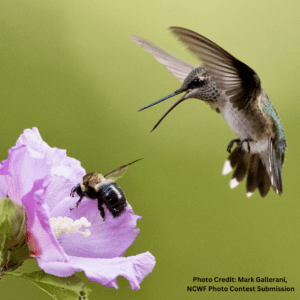The Wide World of Pollinators – A Look at 5 of NC’s Lesser Known Pollinators

How well do you know North Carolina’s lesser known pollinators?
“All nature seems at work … The bees are stirring–birds are on the wing … and I the while, the sole unbusy thing, not honey make, nor pair, nor build, nor sing.” – Samuel Coleridge
You may be unfamiliar with the above line of poetry… but you are undoubtedly familiar with the phrase that it evoked in popular culture:

The birds and the bees.
“the birds and the bees”.
The essential idea is that nature does what nature does in order to meet its needs and contribute to its wider ecosystem – mainly through reproduction and dispersal. And what better species to exemplify these processes than the birds and the bees.
But, realistically, this household phrase should be amended to “the birds and the bees and the butterflies and the wasps and the flies and the hummingbirds and the…”. You get the idea.
There is much attention given to the popular pollinator superheroes: butterflies and bees, of which there are many. But some may not realize that these two pollinator types merely scratch the surface of the pollinators our state’s natural ecosystems and food-producing networks rely upon.
What is Pollination?

A bee performing pollination on a flower stamen.
The Oxford dictionary’s definition of pollination is “the transfer of pollen to a stigma, ovule, flower, or plant to allow fertilization.” Putting
two and two together, pollinators are essentially the vehicle responsible for carrying the materials needed to create new life!
Pollination is actually quite a serendipitous ecological process… meaning, in many cases, it sort of happens by “accident”. Pollinators do not travel from flower to flower to collect pollen and deposit it in another flower with the direct knowledge or intent of performing this act of transference. Rather, pollinators are looking after their own needs, namely searching for food. This food comes in the form of carbohydrate-rich nectar and protein-dense pollen.

A bumblebee covered in pollen.
To obtain these precious food resources, pollinators have to work their way into the innermost parts of a flower. In so doing, they brush up against the rich pollen reserves (the stamen) of the flower.
Examined under a microscope, pollen molecules are not as they appear to the naked eye. What looks to us like fine yellow dust is actually a collection of spherical burrs with spikes and bristles that loosely resemble the bristly side of a piece of velcro. Many pollinators too have bristles in the form of small hairs on their bodies, which function as the softer side of a piece of velcro, adhering the pollen molecules to their bodies.
Once pollinators have gathered a sufficient amount of food from the flower – and accumulated pollen on their bodies in the process – they will head to another flower and perform the same exercise. But as they remove some of the pollen from this flower, they also deposit some from the previous flower.
And just like that… pollination is accomplished, achieving seed and fruit production in the plant – the vehicles of the species’ reproduction.
Exploring North Carolina’s Lesser Known Pollinators
Lesser Known Pollinators – Wasps

When thinking of “cute and fuzzy” pollinators (bumblebees may come to mind), wasps don’t necessarily fit the bill for most people. Wasps appear to be built for combat – with lithe and armored bodies, stingers, and even diets that include other insect species. Nevertheless, wasps perform critical pollinating services.
Even though they do not seek out pollen, it still adheres to the hairs on their exoskeletons during their search for nectar, accomplishing this critical element of the pollination process.
Contrary to most bees, wasps do not seek out pollen for food or gather it for the feeding of young. However, being omnivorous, they do seek out floral nectars in addition to aphids, flies, caterpillars, and other small insects.
Even their intimidating appearance and aggressive demeanor can benefit plants as wasps are highly territorial, fending off pests that may seek to damage the plant.
A few examples of pollinating wasps in North Carolina include:
- Eastern yellowjackets (Vespula maculifrons)
- Finebacked red paper wasp (Polistes carolina)
- Mud-daubers (Sceliphron caementarium)
- Cicada killers (Sphecius speciosus)
- Guinea paper wasp (Polistes exclamans)
Note: While wasps are extremely beneficial insects, they are sometimes known for their aggressive behavior when disturbed and their tendency to take up residence in and around houses (under house eaves, attics, porches, etc). When possible, it is best to leave wasps and their nests alone. However, when issues must be addressed, seek out natural methods of deterrence or removal.
Lesser Known Pollinators – Moths
 Often grouped together with their more flamboyant cousins, butterflies, moths deserve a category of their own.
Often grouped together with their more flamboyant cousins, butterflies, moths deserve a category of their own.
Moths and butterflies share the order Lepidoptera. Butterflies evolved from moths as the daytime equivalent of the nocturnal moths. Though they are primarily active at night, moths as a whole are more prolific pollinators than their daytime counterparts. Some flowers emit their most pungent aromas at night, drawing these nocturnal pollinators to their nectar.
The bodies of moths are covered in a pelt of tiny scales, which appear as a coat of fur on the insect’s abdomen. This coating benefits the moth by keeping it warm during cooler nighttime temperatures and also aids in the collection of large quantities of pollen. However, not all moths are pollinators. Some moths – such as the luna moth – don’t even have mouth features capable of feeding, and so are not drawn to flowers for food.
Additionally, when it comes to pollination, moths have the benefit of numbers. Whereas North Carolina has over 170 species of butterflies, it holds over 2,500 species of moths.
Of course, we can’t name them all here, but a few NC moth species are:
- American ermine moth
- Ailanthus webworm moth
- Black-and-yellow lichen moth
- Hummingbird moth
Note: As nocturnal species, moths are extremely sensitive to light. Though the reasons for their attraction to artificial light sources are not completely understood, these lights pose serious dangers to moth safety. Where possible, remember to turn all outdoor lights off at night.
Lesser Known Pollinators – Flies
 The traditional diddy “Shoo, fly, don’t bother me” is reasonable when referring to the house flies endlessly buzzing around your kitchen. But flies – yes, including those pesky house flies – are also responsible for pollination services!
The traditional diddy “Shoo, fly, don’t bother me” is reasonable when referring to the house flies endlessly buzzing around your kitchen. But flies – yes, including those pesky house flies – are also responsible for pollination services!
Though their pollen collection mechanisms are not as efficient as those on bees, flies pollinate a vast majority of flowering plant species. Similar to wasps, they are omnivorous, seeking out fruit, vegetables, meat, and plant, human, and wildlife waste.
Though flies pollinate a wide range of flowers, they are particularly drawn to flowers with a putrid odor. As small pollinators with short probosci, they have to work their way in close to nectar sources and are therefore adept at pollinating flowers with complex interior systems.
Some flies – like many hoverflies – mimic bee species in appearance as a defense against predators. Though their colors tend to match those of the species they are imitating, a close look at the wings and eyes of the fly will give away its true identity.
Some common pollinating flies include:
Housefly and blowfly (Calliphoridae)
Horsefly (Tabanidae)
Cranefly (Tipuloidea)
Hoverflies (Syrphidae)
Black soldier fly (Stratiomyidae)
Lesser Known Pollinators – Beetles
 In evolutionary history, beetles were some of the first insects to begin pollination practices. However, if flowers could choose their pollinators, beetles may be their least favorite. Whereas many pollinators are rather gentle and meticulous with the flowers they pollinate, beetles are thought of as messy pollinators, commonly chewing through leaves and petals to get to nectar and pollen sources.
In evolutionary history, beetles were some of the first insects to begin pollination practices. However, if flowers could choose their pollinators, beetles may be their least favorite. Whereas many pollinators are rather gentle and meticulous with the flowers they pollinate, beetles are thought of as messy pollinators, commonly chewing through leaves and petals to get to nectar and pollen sources.
They generally prefer large, solitary flowers, and dense clusters of small flowers, as these provide easy access to their desired nectar sources. Similar to flies, beetles are attracted to the more pungent-smelling flowers.
Some examples of pollinating beetles in North Carolina include:
- Flower longhorn beetle (Cerambycidae)
- Checkered beetle (Cleridae)
- Click beetle (Elateridae)
- Sap beetle (Nitidulidae)
Lesser Known Pollinators – Hummingbirds
 As such prolific drinkers of nectar – ingesting their body weight in nectar every day – it should come as no surprise that hummingbirds are also key pollinators.
As such prolific drinkers of nectar – ingesting their body weight in nectar every day – it should come as no surprise that hummingbirds are also key pollinators.
Ruby-throated hummingbirds – and several other hummingbird species – migrate to North Carolina from mid-March to early April, once the temperatures start warming up and plentiful nectar sources are in full bloom. As temperatures drop toward the end of fall and the floral sources become more scarce, most hummingbirds will migrate back to their wintering range in Mexico and Central America.
As birds with slender beaks for siphoning nectar, hummingbirds are particularly savvy at pollinating cone-shaped flowers and flowers with deep and narrow openings. While drawing nectar, pollen clings to the bird’s head and beak, to be passed along to the next flower.
Though other hummingbird subspecies are very occasionally spotted throughout North Carolina, Ruby-throated hummingbirds (Archilochus colubris) are the most prevalent hummingbird species in the state.
Though several other species of hummingbirds are vagrant visitors to North Carolina – including Allen’s (Selasphorus sasin), Rufous (Selasphorus rufus), and Anna’s (Calypte anna) hummingbirds – these are exceedingly rare throughout the state and comprise a mere fraction of pollination services among hummingbirds.
Are you passionate about pollinators and concerned about their future here with us? Consider registering your yard as a Pollinator Pitstop on NCWF’s Butterfly Highway.
Want more content like this? We’ve got you covered…
Written by:

– Bates Whitaker, NCWF Communications & Marketing Manager


